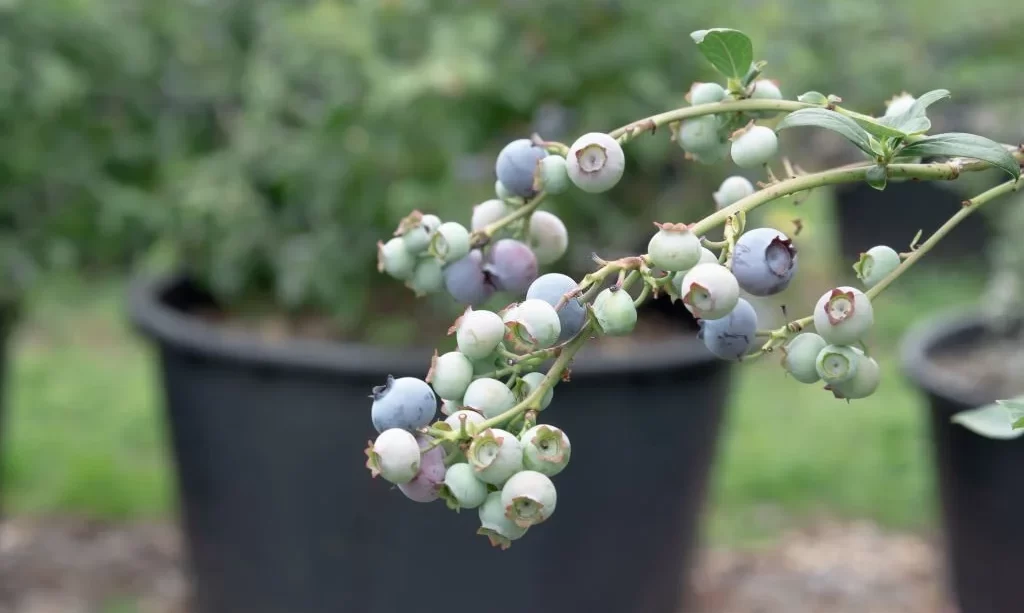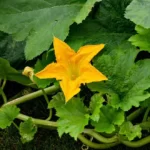Imagine plucking plump, juicy blueberries right from your own garden, no matter how limited your outdoor space may be. It’s not just a dream—it’s the beauty of growing blueberries in pots. Container gardening offers a delightful and space-saving solution for cultivating these delectable berries. Whether you have a small balcony, a patio, or a tiny backyard, you can enjoy the sweet rewards of homegrown blueberries. In this article, we’ll explore the world of growing blueberries in containers and discover why it’s a fantastic choice for both beginners and seasoned gardeners.
- Premium Quality: Our Blueberry Plants are carefully selected and nurtured to ensure you receive a healthy, robust plant that is ready to thrive in your garden.
- Abundant Harvest: This variety is renowned for its generous yield, producing an abundance of plump, sweet berries that are perfect for snacking, baking, or adding to your favorite recipes.
- Exquisite Flavor: The Blueberry boasts an irresistible balance of sweetness and tartness, making it a favorite among blueberry enthusiasts.
- Hardy and Resilient: This plant is highly adaptable and can tolerate a wide range of climates, including both cold and warm regions, making it an excellent choice for home gardeners across various locations.
- Self-Pollinating: The Blueberry is a self-pollinating plant, which means you can grow it as a single specimen and still enjoy a plentiful harvest.
Why Choose Container Gardening for Blueberries
Why should you consider container gardening for blueberries? Well, there are several compelling reasons. Firstly, it’s incredibly versatile. Whether you live in an apartment, a suburban home, or anywhere in between, you can grow blueberries in pots. This adaptability means you can place your blueberry bushes right where they’ll receive the perfect amount of sunlight, all within arm’s reach for easy maintenance and harvesting.
Secondly, container gardening offers precise control over the soil conditions. Blueberries have a particular affinity for acidic soil, and when you grow them in containers, you can tailor the soil mixture to meet their exact needs. This is a game-changer, especially if your garden’s natural soil isn’t quite right for these berries.
Lastly, container-grown blueberries can be an attractive addition to your outdoor space. The pots themselves can be aesthetically pleasing, and when the blueberry bushes burst into a riot of white blossoms in spring and bear their delicious fruit in summer, your container garden will become a focal point of beauty and flavor.
So, if you’re short on space but long for the taste of homegrown blueberries, container gardening is the solution you’ve been looking for. Let’s explore this rewarding journey further and discover how to make it a success.
Selecting the Right Blueberry Varieties
When it comes to growing blueberries in containers, the first step is choosing the right blueberry variety. Not all blueberries are created equal, and some are better suited for container gardening than others. Here are a few considerations:
- Size Matters: Look for blueberry varieties that are specifically bred for compact growth. These smaller bushes are ideal for containers as they won’t outgrow their allotted space. “Patio” or “dwarf” blueberry varieties are excellent choices.
- Self-Pollination or Multiple Varieties: While some blueberry bushes are self-pollinating, meaning they can produce fruit on their own, it’s often a good idea to plant at least two different varieties in separate containers. This encourages cross-pollination, resulting in higher yields of larger and tastier berries.
- Emerald is the considered the standard Southern Highbush Plant. It’s a great healthy plant, good large berry and has a great compact growing habit with low chill requirments.
- The price includes Four (4) “Emerald” Southern Highbush Blueberry Plants with 4 Hello Organic Plant Tags. These are 2 1/4 inch potted plants with at least a two inch root system and are at least 3-5 inches tall.
- Emerald is the most planted Southern Highbush in Florida
- Most all edible plants grow well in Full Sun but a little shade won’t hurt. Blueberry Plants need to be planted in acidic soil/low pH 5.5-6.4. I recommend 60%-80% Pine Mulch/20-40% Peat.
- I recommend growing in 4 inch pot for starter plants then re-pot or plant
Choosing the Right Container
The container you choose plays a vital role in the success of your container-grown blueberries. Here’s what to consider:
- Size and Depth: Blueberries have a relatively shallow root system, so a container with a depth of about 18 inches (45 cm) is typically sufficient. However, larger containers offer more room for root growth and can help maintain moisture levels.
- Drainage: Proper drainage is critical to prevent waterlogged roots. Ensure that your container has drainage holes at the bottom. Elevating the pot slightly off the ground can further aid in drainage.
- Material: Containers made of wood, plastic, or ceramic are all suitable for growing blueberries. Wood containers may require more frequent watering, while plastic and ceramic containers retain moisture better.
- Made of thicker non-woven fabric, strong and durable, fine workmanship, two solid handles
- Ventilation, to strengthen root structure, to increase weed-resistance
- Allows roots to breath and grow healthier, boosts plants growth and yields
- Decreases risk of transplant shock, to improve overall root structure
- Keeps plants warm in winter and cool in summer
Soil and Growing Conditions
The success of your container-grown blueberries hinges on the soil and growing conditions you provide:
- Acidic Soil: Blueberries thrive in acidic soil with a pH level between 4.5 and 5.5. Use a high-quality potting mix formulated for acid-loving plants or create your own mix by blending peat moss, pine bark, and perlite.
- Sunlight: Blueberries require plenty of sunlight to produce bountiful fruit. Place your containers in a location that receives at least 6-8 hours of direct sunlight daily.
- Watering: Blueberries like consistently moist soil but not waterlogged conditions. Water when the top inch of soil feels dry, and use a saucer to catch excess water runoff.
- Temperature: Blueberries prefer cool climates. If you live in a hot region, provide some afternoon shade to protect the plants from scorching heat.
By carefully selecting the right blueberry variety, choosing suitable containers, and creating the perfect soil and growing conditions, you’ll set the stage for a thriving container blueberry garden.
Planting and Maintenance
Once you’ve selected your blueberry variety and container, it’s time to get your hands in the soil:
- Planting: Place your blueberry bush in the container, making sure the top of the root ball is level with the soil surface. Space multiple blueberry bushes according to the variety’s recommended spacing. Water thoroughly after planting.
- Mulching: Apply a layer of mulch, such as pine straw or wood chips, to help retain moisture, regulate soil temperature, and reduce weed competition. Maintain a 2- to 3-inch (5-8 cm) layer of mulch around the base of the plant.
- Fertilizing: Blueberries benefit from acidic fertilizer. Use a slow-release, acid-specific fertilizer according to the package instructions. Avoid over-fertilizing, as it can harm the plant.
- Pruning: Prune your blueberry bush in late winter or early spring to remove dead or damaged branches. This encourages new growth and improves air circulation.
- Pest and Disease Management: Regularly inspect your blueberry plant for signs of pests or diseases. Address any issues promptly to keep your plant healthy.
- Organic plant food ideal for berry fertilization, promoting lusher growth.
- Blueberry fertilizer organic formula that increases fruit yield.
- Perfect strawberry fertilizer organic solution for healthier berries.
- A berry tone organic fertilizer improving soil quality.
- Best organic plant food for any berry plant, soil acidifier blueberry plants love!
Overwintering Blueberries in Containers
When winter approaches, it’s essential to protect your container-grown blueberries:
- Winter Location: Move your containers to a sheltered location, such as a garage or a cool, protected spot. This helps shield the plant from harsh winter winds and extreme cold.
- Insulation: Consider wrapping the containers in insulating materials or using frost blankets to provide extra warmth to the root zone during cold snaps.
- Reduced Watering: During the winter months, blueberries require less water. Allow the soil to partially dry between watering to prevent root rot.
Harvesting Blueberries from Containers
The reward for your care and patience is a bountiful harvest of sweet blueberries:
- Timing: Blueberries are ripe when they turn deep blue with a slight blush. They should easily detach from the stem when gently pulled.
- Gentle Harvesting: Use your fingers to pick ripe berries carefully. Avoid squishing or bruising them.
- Enjoy the Fruits of Your Labor: Freshly picked blueberries are a delight. Eat them as a snack, add them to your morning cereal, or use them in pies, muffins, or smoothies. The possibilities are endless!
Conclusion
Growing blueberries in containers is a delicious adventure that brings the joys of homegrown fruit to even the smallest of spaces. With the right variety, container, soil, and care, you can savor the sweetness of freshly picked blueberries right from your patio, balcony, or garden. Whether you’re a beginner or an experienced gardener, container-grown blueberries offer a satisfying and tasty way to connect with nature and enjoy the fruits of your labor. So, don’t wait—start your container blueberry garden today and experience the delight of homegrown blueberries like never before.








